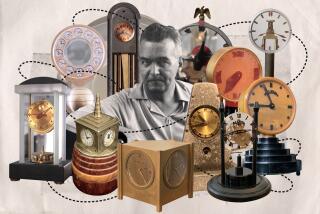Fashion 88 : Watch Wearers Keep Up With the Times
President-elect George Bush told Americans to read his lips, but millions preferred to watch his watch.
That’s because now, more than ever, time talks in America. Watches are status symbols, ranking right up there with real estate and cars. (Bush, you may recall, took a ribbing during the campaign for his “preppie” multicolored watchbands.)
Watches have been known to sway maitre d’s in New York and seal a deal in Hollywood. And they can be equipped with an amazing number of I-have-arrived extras, including an alarm, stopwatch, tachometer, chronograph, multiple time zones, a perpetual calendar (gives day, date, month, phase of the moon and leap year until the year 2100), tide level, elapsed time (useful for scuba divers and knowing when the parking meter will run out), celestial time and astrological signs.
Despite hundreds of models created to satisfy the current watch craze, hardly a second seems to go by without a fresh face. As if to beat 1988’s clock, a number of companies rushed forward with new timepieces between October and December.
Louis Vuitton introduced two watches, including one for $11,500 with a large, tricolored, busy face that indicates phases of the moon, local time and time anywhere from Tahiti to Tokyo--all wrapped in a handcrafted, 18-karat gold case.
Prestige jeweler Harry Winston entered the watch business in early December with the Ultimate Timepiece collection, priced from $15,000 to $90,000, for which the owner gets a limited edition, custom-made watch, protected by Lloyd’s of London. There is also a pick-up-and-deliver repair service that comes with an equal-or-better loaner from the very same collection.
A few days later, Patek Philippe, considered one of Swizerland’s finest watchmakers, announced the company’s 150th anniversary next year would be celebrated with three limited-edition styles (one for women, two for men) along with an auction that will include the world’s “most complicated portable timepiece,” the Calibre ’89. According to a company spokesperson, the brand-new Calibre ’89 should “fetch in the millions” at the April 9 auction in Geneva. Among its 31 functions, it will give the date of Easter for the next 30 years and chart the galaxies over Geneva.
In a far more moderate price category, Timex added something new: its first-ever retail store, which opened two weeks ago in Trumbull, Conn. It will serve as a testing ground for the company’s 300 watch styles, all priced under $100.
“Consumers can vote with their money,” explains C. Michael Jacobi, vice president of marketing and sales.
Timex also won year-end kudos from USA Today for the humorous revival of its old ad slogan: “It takes a licking and keeps on ticking” used now to promote watches such as the Timex Ironman, “the biggest selling (about 1.5 million a year) sports watch in the United States,” Jacobi says.
A lone Hamilton, Gruen, Bulova, Elgin or Timex to last a lifetime might have been the idea back in the ‘50s, but this is the era of wardrobes of timepieces to match wardrobes of clothing. To bombard consumers with that message, companies spend millions on advertising. (Timex’s media budget for 1988 was close to $15 million, according to account supervisor Mary Weber of Fallon McElligott.) Sometimes, of course, the word hits the wrong target.
Jack Greiff, vice president of Tourneau Inc., talking from the company’s store in Manhattan, explained that an ad in the New York Times last Saturday for a $41,000 Gerald Genta watch drew a call from an editor of the New York Post. He thought the figure was a mistake: “He said his house hadn’t cost that much.”
Learning the price was right, he sent a reporter and photographer out on Monday, but by that time the watch had been sold and the pair had to be content with a look at a $46,500 Patek Philippe.
“Today, there are no bad watches,” Greiff says. “Any quartz is going to keep accurate time. But a gold watch certainly has status. A Patek Philippe, an Audemars Piguet, a Cartier are instantly identifiable. The strength of the Rolex is that people recognize it,” notes Greiff, adding that many watch fanciers won’t buy quartz. They want their tick from a manual or a self-winding mechanism.
Los Angeles film producer Larry Thompson explains: “Quartz takes the fun away. It’s like going to the pyramids and finding a little battery under them.” His own collection “is a revolving set of 12 watches. I’m always trading up. I’m fascinated with time and the timepieces that people wear.”
In the past, he has worn a Rolex, which he now considers “passe; 10 to 15 years ago, it was a status symbol. Then you started to see men and women wear it so much that it has become very commercial. Also, the style of all that gold has become tacky. I think you’re seeing people go for less jewelry, more timepieces.”
Thompson prefers an Audemars Piguet (his is a rose-gold chronograph on an alligator band): “ The most perfect timepiece made today,” he insists. “It will be the next Rolex, even though it’s much more expensive.”
But price is not always the issue. Thompson used to wear a $25 moon-face quartz watch (purchased “eight years ago when it was hard to find a new moon-face watch”) on the same wrist with a costly Rolex Prince, which he set a day ahead “because I tend to work in the future.”
His tux timepiece is an $85 gold-plated antique with a black leather band, found in a little shop in England: “It has to get really geared up to work. But it’s very thin and classic. I don’t like wearing a big, clunky timepiece with a tuxedo.”
At Second Time Around Watch Co. in West Hollywood, the specialties of the house are antique timepieces that are benefiting from modern watch mania, according to owner Sig Shonholtz: “People are recognizing the beauty of old watches. You look at new watch designs and they clearly reflect old ideas. It’s also the price. A nice vintage watch will cost less money than a modern one, and in most cases it will be finer quality.”
Four hundred dollars will purchase a vintage Hamilton, rated by Shonholtz as “the best watch ever made. And it’s a way to be distinctive. When you buy an antique watch, you won’t see it on everybody.”
At Bullocks Wilshire--where estate watches are sold along with newer Cartier, Baume & Mercier, Gucci and Movado styles--Bala Chandran, the chain’s fine-jewelry buyer, notes that among today’s trends: “Larger-faced watches are being worn by women. Gold is preferred by both sexes. Otherwise, it’s an alligator or lizard strap in black, dark brown or burgundy.”
Marty Klein, president of the Agency for the Performing Arts, has eight watches, including a gold Cartier Panther. He decides which one he’ll wear “depending upon my mood. It’s a lot like picking a tie.” His wife has four watches of her own, “but she’ll also use some of mine.”
Klein’s collection is eclectic. There’s the Cartier that was a present from his wife. A Patek Philippe that was a present from Steve Martin. And a Swatch, with the days printed in French, which Klein bought in Switzerland. “I just wanted one, and I figured I’d get a Swiss Swatch.”
By all accounts, Swatch started the current watch revolution. Five years ago, the company turned robot-constructed timepieces into fashion accessories and promoted the concept of multiple purchases (followed by the short-lived fad of multiple watches on one arm).
Today, Swatch is alive and well, according to Steve Rechtschaffner, vice president of advertising and promotion for Swatch Watch U.S.A. Known for colorful plastic designs--priced from $35-$45--that are updated monthly, the company is going in new directions.
In January, Swatch launches its Hardware collection with metal bands. Love Field, a collection “named after the first commercial aviation field in Dallas,” will have soft leather bands and a metal cap. “For someone who wears a bomber jacket and boat shoes, Love Field makes sense,” Rechtschaffner explains.
And when a Swatch customer can upgrade to a Cartier or Audemars Piguet? “What we’ve done is orient people to think about watches as an accessory--like a tie or socks. If a person is making three times more money, I don’t think we lose them,” Rechtschaffner says.
“It’s a small way to say, ‘I like being different.’ It’s not like wearing goofy sunglasses right in the middle of your face. But in traditional circles, it’s the way some people rebel. I’ve seen businessmen who could afford more wear a Swatch. To some people, it’s an anti-status symbol that says: ‘I don’t need to buy a $10,000 watch to make a statement.’ ”






